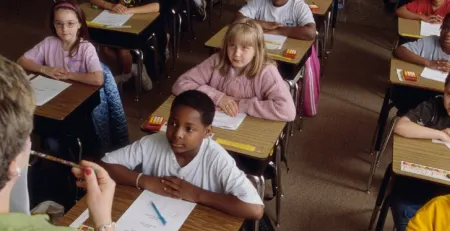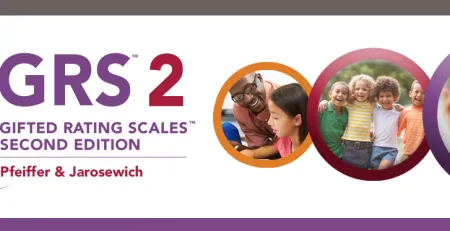The Gifted Rating Scales™ Second Edition: An Interview with author Dr. Steven Pfeiffer
Dr. Steven Pfeiffer is the co-author of MHS’ Gifted Rating Scales™ Second Edition (GRS™ 2), and author of his latest book, Parenting from the Heart, Raising Resilient and Successful Smart Kids.
We sat down with Dr. Pfeiffer to discuss his early work in psychology and his entry into the gifted field—along with what inspired the initial development of the Gifted Rating Scales™ (GRS) and the advancement of the newly revised GRS 2.
The interview below has been edited for length and clarity.
DR. PFEIFFER: I started out early on as a pediatric and clinical child psychologist in a medical center. I also worked for a number of years as a clinical psychologist in the Navy Medical Service Corps. Early in my doctoral studies, I had a great interest in creativity and creative problem-solving. I investigated creative thinking in children with James Gallagher, who was part of my dissertation committee at the University of North Carolina-Chapel Hill. However, I didn’t fully immerse myself in the gifted field until 1998, when I had the good fortune of being invited to apply for the position as Executive Director of Duke University’s gifted program (Duke TIP), where I served as Director for a number of years. That’s where I got very involved in trying to understand high ability children and began my work on the GRS.
What initially led you to develop the original GRS, first published back in 2003?
DR. PFEIFFER: During my tenure as director of Duke University’s gifted program, I was struck by the fact that there really weren’t many instruments or tests or scales to assist in the identification of high ability children other than the IQ test score. It seemed to me that the field desperately needed alternative and additional measures that went beyond just looking at a young child’s IQ score. In addition, many bright students weren’t being identified in the schools in the U.S. and globally. It seemed that we needed to create a very user-friendly, inexpensive scale to assist educators and administrators in identifying high-ability youth. For these reasons I embarked upon developing the Gifted Rating Scales.
What was the impetus for revising the Gifted Rating Scales?
DR. PFEIFFER: The original Gifted Rating Scales, published in 2003, were cutting-edge in terms of an easy-to-use, highly reliable, and accurate measure to assist IQ tests in providing a more comprehensive picture of bright and able young children. However, both MHS and my co-author, Dr. Tania Jarosewich, and I realized that the time was right for us to develop a new standardization sample for the GRS. Also, my work in the field has led me to strongly feel that we really should have a companion scale to the teacher rating scale – a parent scale – so that parents could provide their perspectives or insights into their child. Third, the original GRS went up through age 13:11. In consulting with schools across the country and internationally, we realized that there was a growing interest in being able to assess older youth. So, we decided to expand the age range of the GRS when designing the GRS 2.
Finally, there were many new, creative, and thoughtful enhancements that psychometricians and test developers had developed since the original GRS. We said we really wanted to build these into the new GRS 2 so that we would have a state-of-the-art test that was working in the 21st century —that was fair for all children, unbiased, easy to use, and was cutting-edge in terms of identifying youth who were bright and able. Back in my work at Duke University, I developed what is called the tripartite model of giftedness. Essentially, I wanted to look beyond just high intelligence or cognitive ability, and we wanted to include youth who were extraordinarily capable in academics and other talented areas. Finally, we hoped to develop an instrument that could identify youth with high potential who weren’t quite yet demonstrating their abilities. So, that tripartite model was also used to develop the new GRS 2.
How does the Gifted Rating Scales™ Second Edition (GRS™ 2) relate to your work on the “Strengths of the Heart” idea?
DR. PFEIFFER: As a clinician, I was always interested in working with high-ability youth to look beyond what I consider head strengths into heart strengths. My interest was in understanding the whole child, not just how creative and intellectually precocious a high-ability youth was. So, we did a lot of work in my research lab at Duke and then subsequently at Florida State University into what has evolved into what we call strengths of the heart. Essentially, we’re interested in trying to understand what goes into the success, the life success of bright enabled young children above and beyond high intellectual ability. Ultimately, we came up with three super traits that seem to make a real difference in the lives of youth when they grow up and become successful young adults. These three super traits are emotional intelligence, social skills, and character strengths. So, those three went into the model of strengths of the heart, and interestingly enough, I built those into the parent form of the GRS 2. So, we’re really excited that our work in understanding the whole child, the whole gifted child, was incorporated into the new GRS 2 Parent Form.
Tell us a bit about your co-author, Dr. Tania Jarosewich – how did you two come together to author this assessment?
DR. PFEIFFER: Tania Jarosewich joined us at Duke University as a postdoc. We were excited when we recruited her as our first postdoc. She had extensive experience in the schools as a school psychologist, and in addition, she was quite savvy and knowledgeable in statistics and psychometrics. I wanted to develop this new rating scale at the time, and I thought Tania would be a great co-author. She had hands-on experience with young children and working with teachers and administrators. In addition, she supported me in terms of her wealth of knowledge on statistics. So, it’s been a really good relationship over the years.
What are the components that make up the GRS 2?
DR. PFEIFFER: So, the GRS 2 has gone way beyond the original GRS. First and foremost, we developed a parent rating scale as a companion to the teacher scale. We feel very strongly that we want to provide teachers, educators, and others who work with students, with multiple perspectives on students’ abilities and capabilities. If we could develop a scientifically sound and reliable instrument that worked from a parent’s perspective, we would add something unique to the assessment field. So, that’s one of the first major components of the new GRS 2.
We decided to reduce the number of items from the original scale (the GRS to the GRS 2) to make it more streamlined, easier to complete, and quicker and that relates to the third fact, which is we wanted to go beyond using the GRS 2 for individual students to use it for groups of students and classes. It has been very effectively used as a group screening tool. So, we thought if we reduced the number of items and kept it highly reliable, accurate, and valid, we’d have an even more user-friendly tool. MHS worked closely with us in building a number of enhancements that provide the user with an online report that details a student’s relative strengths. We designed the scale to be used for both Spanish-speaking and English-speaking parents.
Finally, I would say that we were exquisitely careful in ensuring that every item and scale was uniquely fair for every child who would be considered a potentially gifted and talented youth.
What makes the GRS 2 unique in its approach? How is it making a difference?
DR. PFEIFFER: Going back to my early experience at Duke University in 1998 and 1999, we were concerned that the field focused almost exclusively on high IQ and identifying gifted, intelligent youth. So historically, the original GRS and now the exciting new GRS 2 have expanded the perspective to provide educators with multiple perspectives on gifted and talented beyond just high intellectual or cognitive ability. So, the GRS is a great companion to the very popular IQ tests that exist in the field, but in addition, it expands a teacher’s understanding of abilities beyond just cognitive ability.










